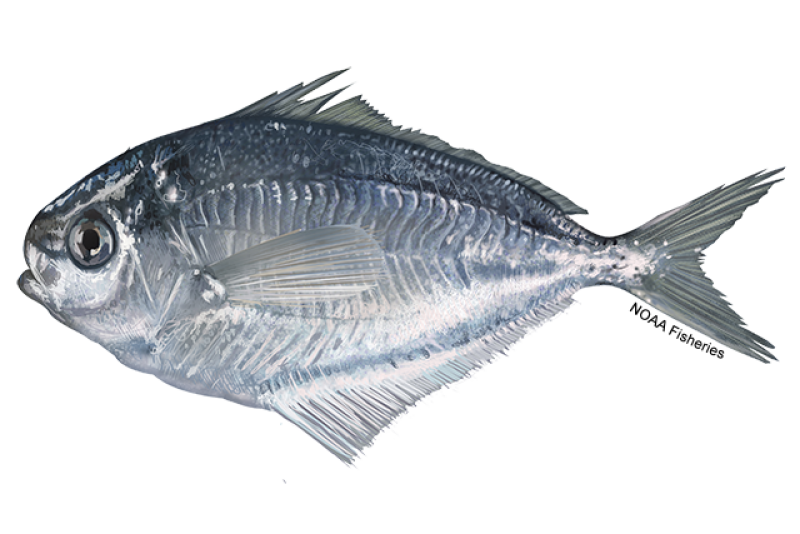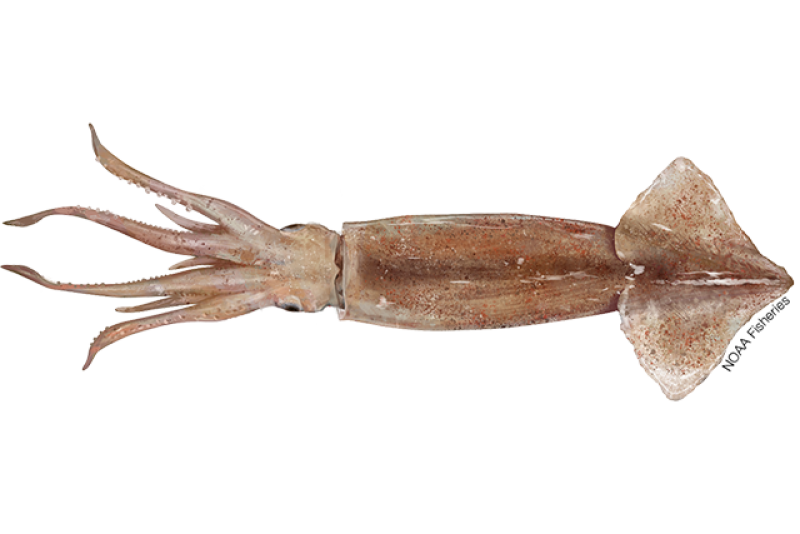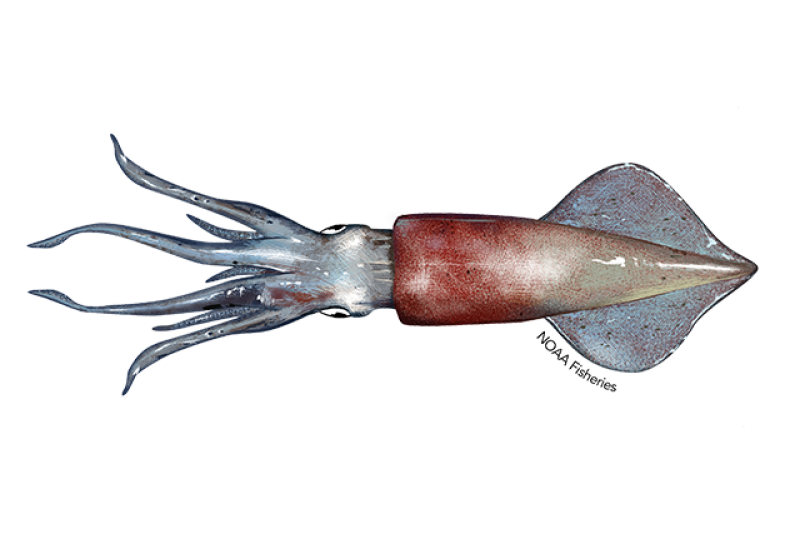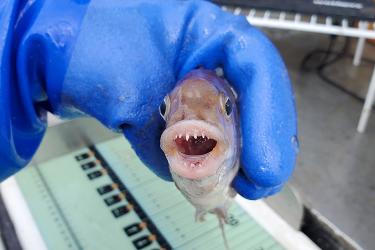Butterfish
 Butterfish (Peprilus triacanthus). Credit: NOAA Fisheries/Katie Rogers
Butterfish (Peprilus triacanthus). Credit: NOAA Fisheries/Katie Rogers
Butterfish (Peprilus triacanthus). Credit: NOAA Fisheries/Katie Rogers
About the Species
 Butterfish (Peprilus triacanthus). Credit: NOAA Fisheries/Katie Rogers
Butterfish (Peprilus triacanthus). Credit: NOAA Fisheries/Katie Rogers
Butterfish (Peprilus triacanthus). Credit: NOAA Fisheries/Katie Rogers
U.S. wild-caught butterfish is a smart seafood choice because it is sustainably managed and responsibly harvested under U.S. regulations.

Population
The stock is not overfished.

Fishing Rate
Not subject to overfishing.

Habitat Impact
Fishing gears used to harvest butterfish have minimal impacts on habitat.

Bycatch
Regulations limit possession of bycatch species and require modified fishing gear to reduce bycatch.
Population Status
- According to the 2022 stock assessment, butterfish is not overfished and not subject to overfishing. Summary stock assessment information can be found on Stock SMART.
- Scientists at NOAA’s Northeast Fisheries Science Center survey the abundance of butterfish off the East Coast.
- They added temperature and habitat information into the stock assessment model, which helps them more accurately estimate fish abundance. Using this approach, the model indicated that the population was more abundant than previously estimated.
- Incorporating this type of environmental information into stock assessments will become increasingly important as the climate changes and the oceans warm.
Appearance
- Butterfish are dull blue on the top, with pale sides and a silvery belly. Numerous irregular dark spots fade after they are harvested.
- Very thin and deep-bodied, like a flounder set upright, and somewhat circular or rounded.
- Small mouths with weak teeth and blunt noses.
- 6 to 9 inches in length, though some individuals can reach 12 inches.
- Up to 1.25 pounds in weight.
Biology
- Butterfish are short-lived and grow rapidly.
- Few live to more than 3 years of age, and most are sexually mature at age 1.
- Spawning occurs during June and July.
- They are semi-pelagic, and form loose schools that feed upon small invertebrates.
- They have a high natural mortality rate and are preyed upon by many species of fish, marine mammals, and seabirds.
Where They Live
Range
- Butterfish are found from Florida to Newfoundland, but they are primarily found from Cape Hatteras to the Gulf of Maine.
Habitat
- Butterfish shift their distribution in response to changing bottom water temperatures.
- During summer, they move northward and inshore to feed and spawn.
- During winter, they move southward and offshore to avoid cold waters.
Fishery Management
- NOAA Fisheries and the Mid-Atlantic Fishery Management Council manage the butterfish fishery.
- Managed under the Atlantic Mackerel, Squid, and Butterfish Fishery Management Plan:
- Fishermen must have a permit to harvest butterfish. Managers limit the amount of available permits to control harvests.
- Annual catch limits are in place to prevent overfishing.
- Managers monitor commercial catch weekly.
- Vessel trip limits are based on gear mesh sizes, and are adjusted based on landings.
Harvest
- In 2022, commercial landings of butterfish totaled 1.8 million pounds and were valued at $1.6 million, according to the NOAA Fisheries commercial fishing landings database.
- Butterfish are primarily landed in Point Judith and North Kingstown, Rhode Island; Montauk, New York; and New Bedford, Massachusetts. They are generally exported to Japan, where they are a popular menu item.
- Otter trawls are used to catch butterfish.
- Otter trawls can incidentally catch other fish and marine mammals as bycatch, and can impact habitat, depending on where they are used.
- Gear restrictions (minimum mesh size) when fishing with otter trawls are used to reduce bycatch.
Scientific Classification
- Butterfish are found from Florida to Newfoundland, but they are primarily found from Cape Hatteras to the Gulf of Maine.
- Butterfish shift their distribution in response to changing bottom water temperatures.
- During summer, they move northward and inshore to feed and spawn.
- During winter, they move southward and offshore to avoid cold waters.
Fishery Management
- NOAA Fisheries and the Mid-Atlantic Fishery Management Council manage the butterfish fishery.
- Managed under the Atlantic Mackerel, Squid, and Butterfish Fishery Management Plan:
- Fishermen must have a permit to harvest butterfish. Managers limit the amount of available permits to control harvests.
- Annual catch limits are in place to prevent overfishing.
- Managers monitor commercial catch weekly.
- Vessel trip limits are based on gear mesh sizes, and are adjusted based on landings.
Harvest
- In 2022, commercial landings of butterfish totaled 1.8 million pounds and were valued at $1.6 million, according to the NOAA Fisheries commercial fishing landings database.
- Butterfish are primarily landed in Point Judith and North Kingstown, Rhode Island; Montauk, New York; and New Bedford, Massachusetts. They are generally exported to Japan, where they are a popular menu item.
- Otter trawls are used to catch butterfish.
- Otter trawls can incidentally catch other fish and marine mammals as bycatch, and can impact habitat, depending on where they are used.
- Gear restrictions (minimum mesh size) when fishing with otter trawls are used to reduce bycatch.
Scientific Classification
| Kingdom | Animalia | Phylum | Chordata | Class | Actinopterygii | Order | Scombriformes | Family | Stromateidae | Genus | Peprilus | Species | triacanthus |
|---|
Last updated by NOAA Fisheries on 06/23/2025
Featured News
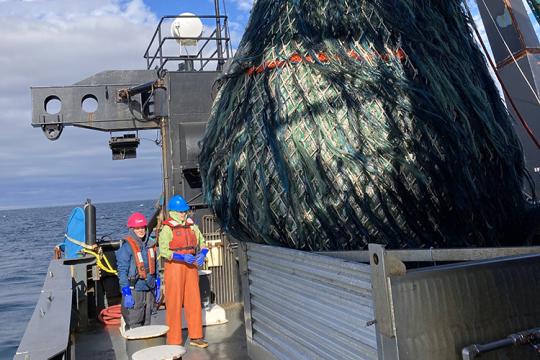 After each survey tow, the net is retrieved and the catch is emptied into a hopper where a series of conveyors move the catch to the sorting and processing area aboard the NOAA Ship Henry B. Bigelow. There, scientists sort the catch and collect data and biological samples. Credit: NOAA Fisheries/Jessica Blaylock
After each survey tow, the net is retrieved and the catch is emptied into a hopper where a series of conveyors move the catch to the sorting and processing area aboard the NOAA Ship Henry B. Bigelow. There, scientists sort the catch and collect data and biological samples. Credit: NOAA Fisheries/Jessica Blaylock

Research Addresses Need for Bottom Trawl Survey Gear Standardization
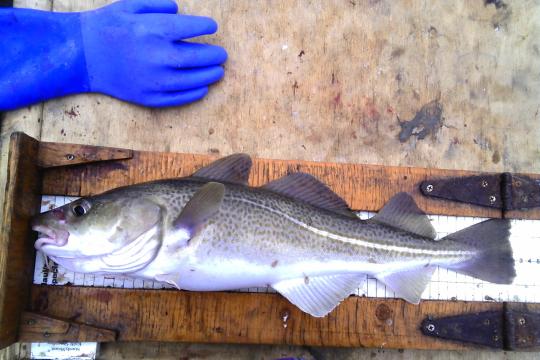
Recreational Fishing Regulations
Possession Limits:
There is no recreational possession limit for butterfish. If you are on a trip carrying paying customers and you possess butterfish in federal waters, you must hold a Category 2 Squid/Mackerel/Butterfish Charter Party permit.
Fish Size Limits:
Minimum Fish Size: None
Maximum Fish Size: None
Reporting A Recreational Catch
Charter/Party and Recreational Reporting
Catch Reporting and Vessel Trip Reports
If the owner of a party or charter boat is issued only a charter/party permit, and is carrying passengers for hire, then they must complete a VTR for each trip on which they land any fish.
Interactive Voice Response System Requirements
The Atlantic mackerel, squid, and butterfish fisheries do not have any IVR requirements. However, if you are participating in a research program such as research set-aside (RSA) or fishing with an exempted fishing permit (EFP), there are IVR requirements. Please refer to your RSA or EFP paperwork for instruction on using IVR.
Marine Recreational Information Program
The Marine Recreational Information Program (MRIP) is a system of coordinated voluntary data collection programs designed to estimate recreational catch and effort.
Last updated by NOAA Fisheries on 06/23/2025
Commercial Fishing Regulations
Current Specifications
Specifications are reviewed annually and are adjusted as new information becomes available.
2024 Butterfish Specifications in Metric Tons (mt)
Specification | 2024 |
Overfishing limit (OFL) | 16,096 |
Acceptable biological catch (ABC)/annual catch limit (ACL) | 15,764 |
Annual catch target (ACT) | 14,976 |
Assumed discards | 1,248 |
Total discard set-aside (all sources) | 5,132 |
Butterfish cap in longfin squid fishery | 3,884 |
Domestic annual harvest (DAH) | 9,844 |
Trip Limits
Permit Type | Possession Limit |
| SMB 6 Butterfish Moratorium | Unlimited/5,000 lb* |
| SMB 3 Squid/Butterfish Incidental | 600 lb |
*See Commercial Gear Information section of this page (below).
Fish Size Limits
Minimum fish size: Not applicable
Maximum fish size: Not applicable
Accountability Measures
These accountability measures are only for the SMB 1 permit
1,000 mt less than 100% | 5,000 lb per trip |
100% | 600 lb per trip |
If the butterfish ACL is exceeded, then the exact amount of the overage will be deducted from the butterfish ACL by March 31 of the following year as a single-year adjustment.
Reporting A Commercial Catch
Catch Reporting and Vessel Trip Reports (VTR)
Owner/operators participating in the Atlantic mackerel, Illex squid, and Longfin squid/butterfish must submit trip reports weekly. Reports must be postmarked or received by midnight of the Tuesday following the reporting week (Sunday through Saturday). If a trip starts in one week, and offloads in the next, it should be reported in the week the catch was offloaded.
Interactive Voice Response (IVR) System Requirements
The Atlantic mackerel, squid, and butterfish fisheries do not have any IVR requirements. However, if you are participating in a research program such as research set-aside (RSA) or fishing with an exempted fishing permit (EFP), there are IVR requirements. Please refer to your RSA or EFP paperwork for instruction on using IVR.
Vessel Trip Reports
Copies of fishing log reports must be kept on board the vessel and available for review for at least one year, and must be retained for a total of three years after the date the fish were last possessed, landed, and sold.
Commercial Gear Information
Vessels fishing with otter trawl gear that possess 5,000 lb or more of butterfish, must use nets that have a minimum codend mesh of 3 inches (76 mm) mesh, inside stretch measure, applied throughout the codend for at least 100 continuous meshes forward of the end of the net. For codends with less than 100 meshes, one-third of the net must have a minimum mesh of 3 inches, measured from the back of the codend to the headrope.
Last updated by NOAA Fisheries on 06/23/2025
Seafood Facts

Is Butterfish Sustainable?
U.S. wild-caught butterfish is a smart seafood choice because it is sustainably managed and responsibly harvested under U.S. regulations.
Availability
Year-round.
Source
U.S. wild-caught from Maine to South Carolina.
Taste
Fatty, oily, and delicious.
Health Benefits
Butterfish is a good source of niacin, vitamin B6, phosphorus, protein, vitamin B12, and selenium.
Nutrition Facts
Servings: 1; Serving Weight: 100 g (raw); Calories: 146; Protein: 17 g; Total Fat: 8 g; Total Saturated Fatty Acids: 3.4 g; Carbohydrate: 0 g; Total Sugars: 0 g; Total Dietary Fiber: 0 g; Cholesterol: 65 mg; Selenium: 36.5 mcg; Sodium: 89 mgMore Information
Last updated by NOAA Fisheries on 06/23/2025
Seafood News
 Celebrate Culinary Arts Month with a sustainable seafood recipe for every month of the year.
Celebrate Culinary Arts Month with a sustainable seafood recipe for every month of the year.
What Your Birth Month Says About Your Next Seafood Recipe
 Fresh-caught taʻape on ice. Credit: Conservation International Hawaiʻi.
Fresh-caught taʻape on ice. Credit: Conservation International Hawaiʻi.
Reducing Waste and Feeding Communities in Hawaiʻi with a Whole Fish Approach
 Chef Tyler Hadfield’s Curried Skate Wings with Tomato-Masala Chutney
Chef Tyler Hadfield’s Curried Skate Wings with Tomato-Masala Chutney
Ring In the New Year With These Crowd-Favorite Seafood Recipes
 NOAA Fisheries, in collaboration with Blue Ocean Mariculture, is conducting a multi-year pilot study to evaluate observational methods and tools for studying Hawaiian monk seal behavior. Courtesy of Blue Ocean Mariculture
NOAA Fisheries, in collaboration with Blue Ocean Mariculture, is conducting a multi-year pilot study to evaluate observational methods and tools for studying Hawaiian monk seal behavior. Courtesy of Blue Ocean Mariculture
AI Meets Aquaculture to Study Hawaiian Monk Seal Interactions With Net Pens
Regulated, Closed, and Access Areas
Atlantic Mackerel, Squid, and Butterfish Fishery Restricted Areas
January 1 – December 31 | January 1 – December 31 | November 1 – December 31 | January 1 – March 15 |
Bottom trawl gear prohibited | Bottom trawl gear prohibited | Minimum mesh size of 5.0 inch diamond mesh | Minimum mesh size of 5.0 inch diamond mesh |
Transit allowed if bottom trawl gear is stowed and not available for immediate use. | Transit allowed if bottom trawl gear is stowed and not available for immediate use. | Transit allowed if codends less than 5.0 inches are stowed and not available for immediate use. | Transit allowed if codends less than 5.0 inches are stowed and not available for immediate use. |
| Applies to all permitted mackerel, squid, or butterfish vessels | Applies to all permitted mackerel, squid, or butterfish vessels | Applies to all trawl vessels fishing for longfin squid, black sea bass, or silver hake (whiting) | Applies to all trawl vessels fishing for longfin squid, black sea bass, or silver hake (whiting) |
*Coordinates for each area are listed below.
Oceanographer Canyon Coordinates
N. Lat. | W. Long. |
40°10.0' | 68°12.0' |
40°24.0' | 68°09.0' |
40°24.0' | 68°08.0' |
40°10.0' | 67°59.0' |
40°10.0' | 68°12.0' |
Lydonia Canyon Coordinates
N. Lat. | W. Long. |
40°16.0' | 67°34.0' |
40°16.0' | 67°42.0' |
40°20.0' | 67°43.0' |
40°27.0' | 67°40.0' |
40°27.0' | 67°38.0' |
40°16.0' | 67°34.0' |
Scup Gear Restricted Areas (GRA)
Southern GRA |
| Northern GRA | ||
N. lat. | W. long. | N. lat. | W. long. | |
39°20' | 72°53' | 41°00' | 71°00' | |
39°20' | 72°28' | 41°00' | 71°30' | |
38°00' | 73°58' | 40°00' | 72°40' | |
37°00' | 74°43' | 40°00' | 72°05' | |
36°30' | 74°43' | 41°00' | 71°00' | |
36°30' | 75°03' |
|
| |
37°00' | 75°03' |
|
| |
38°00' | 74°23' |
|
| |
39°20' | 72°53' |
|
| |
More Information
Last updated by NOAA Fisheries on 06/23/2025
Management Overview
How is the fishery managed?
Mackerel, squid, and butterfish are jointly managed in federal waters by NOAA Fisheries and the Mid-Atlantic Fishery Management Council. The butterfish fishery is managed through the use of permits, annual quotas, discard caps, accountability measures, and possession limits.
What is the fishing year for this fishery?
January 1 – December 31.
What are the different management areas for this fishery?
The management unit for butterfish is the Atlantic Coast, but this species is predominately targeted from Maine to North Carolina.
Management Plans
Mackerel, squid, and butterfish are managed in federal waters under the Atlantic Mackerel, Squid and Butterfish Management Plan (FMP).
Regulatory History
Management Timeline
1978: Atlantic Mackerel FMP established management of Atlantic mackerel fishery
1978: Atlantic Butterfish FMP established management of Atlantic butterfish fishery
1978: Squid FMP established management of squid fisheries
1979: Atlantic Mackerel Amendment 1 continued management of the Atlantic mackerel fishery
1979: Squid Amendment 1 continued management of the squid fishery
1980: Atlantic Butterfish Amendment 1 continued management of the Atlantic butterfish fishery
1980: Atlantic Mackerel Amendment 2 continued management of the Atlantic mackerel fishery.
1980: Atlantic Butterfish Amendment 2 continued management of the Atlantic butterfish fishery.
1983: Merged FMP consolidated management of Atlantic mackerel, squid, and butterfish fisheries under a single FMP.
1984: Amendment 1 implemented squid OY adjustment mechanism and revised the Atlantic mackerel mortality rate.
1986: Amendment 2 revised squid bycatch TALFF allowances, implemented framework adjustment process, converted expiration of fishing permits from indefinite to annual, and equated fishing year with calendar year.
1991: Amendment 3 established overfishing definitions for all four species.
1991: Amendment 4 limited the activity of directed foreign fishing and joint venture transfers to foreign vessels and allowed for specification of OY for Atlantic mackerel for up to three years.
1996: Amendment 5 adjusted Loligo MSY; eliminated directed foreign fisheries for Loligo, Illex, and butterfish; instituted a dealer and vessel reporting system; instituted an operator permitting system; implemented a limited access system for Loligo, Illex and butterfish; and expanded the management unit to include all Atlantic mackerel, Loligo, Illex, and butterfish under U.S. jurisdiction.
1997: Amendment 6 revised the overfishing definitions for Loligo, Illex, and butterfish; established directed fishery closure at 95 percent of DAH for Loligo, Illex and butterfish with post-closure trip limits for each species; and established a mechanism for seasonal management of the Illex fishery to improve the yield-per recruit.
1997: Amendment 7 established consistency among FMPs in the NE region of the U.S. relative to vessel permitting, replacement and upgrade criteria.
1998: Amendment 8 brought the FMP into compliance with new and revised National Standards and other required provisions of the Sustainable Fisheries Act. This action also added a framework adjustment procedure.
2001: Framework 1 (PDF, 80 pages) created a quota set-aside for the purpose of conducting scientific research
2002: Framework 2 (PDF, 4 pages) extended the moratorium on entry to the Illex fishery for an additional year; established that previous year specifications apply when specifications for the management unit are not published prior to the start of the fishing year (excluding TALFF specifications); and allowed for the specification of management measures for Loligo for a period of up to three years.
2003: Framework 3 (PDF, 3 pages) extended the moratorium on entry to the Illex fishery for an additional year.
2004: Framework 4 extended the moratorium on entry to the Illex fishery for an additional five years
2007: Amendment 12 implemented standardized bycatch reporting methodology.
2008: Amendment 9 allowed for multi-year specifications for all four managed species (mackerel, butterfish, Illex, and Loligo) for up to 3 years; extended the moratorium on entry into the Illex fishery, without a sunset provision; adopted biological reference points for Loligo recommended by the stock assessment review committee (SARC); designated EFH for Loligo eggs based on available information; and prohibited bottom trawling by MSB-permitted vessels in Lydonia and Oceanographer Canyons.
2010: Amendment 10 implemented a butterfish rebuilding program, increased the Loligo minimum mesh in Trimesters 1 and 3, and implemented a 72-hour trip notification requirement for the Loligo fishery.
2010: Amendment 13 implemented Annual Catch Limits (ACLs), Annual Catch Targets (ACTs), and Accountability Measures (AMs).
2011: Amendment 11 implemented Limited Access in the Atl. mackerel fishery, updated EFH for all MSB species, and established a recreational-commercial allocation.
2012: Framework 5 broadened the scope of individuals who can perform hold measurements for limited access mackerel vessels
2012: Framework 6 clarified the Council's risk policy and describes the limited circumstances under which acceptable biological catch (ABC) can be increased for stocks without status determination criteria on overfishing.
2013: Framework 7 converted the butterfish mortality cap from a catch cap to a discard cap
2014: Amendment 14 implemented a variety of reporting and monitoring requirements for Atlantic mackerel and longfin squid fisheries, and implemented a river herring and shad catch cap for the Atlantic mackerel fishery (Appendices). Final Rule.
2013: Amendment 17 modified accountability measures for the Council's recreational fisheries, including Atlantic mackerel. Final Rule.
2014: Framework 8 implemented changes to improve operation of the butterfish discard cap in the longfin squid fishery and the directed butterfish fishery. Final Rule.
2015: Amendment 15 implemented Standardized Bycatch Reporting Methodology. Final Rule.
2015: Amendment 19 eliminated the requirement for vessel owners to submit "did not fish" reports for the months or weeks when their vessel was not fishing. This action also removed some of the restrictions for upgrading vessels listed on Federal fishing permits. Final Rule.
2015: Framework 9 established measures to enhance catch monitoring and address slippage (catch that is discarded before it has been sampled by observers) in the Atlantic mackerel fishery.
2016: Amendment 16 - Deep Sea Corals Amendment established management measures to protect deep sea corals from the impacts of commercial fishing gear in the Mid-Atlantic region. Final Rule.
2017: Amendment 18 - Unmanaged Forage Omnibus Amendment implemented management measures to prevent the development of new, and the expansion of existing, commercial fisheries on certain forage species in the Mid-Atlantic. Final Rule.
2017: Framework 10 - Omnibus For-Hire Electronic Trip Reporting Framework implemented a requirement for vessels that hold party/charter permits for Council-managed species to submit vessel trip reports electronically (eVTRs) while on a trip carrying passengers for hire.
2018: Framework 11 - Omnibus Acceptable Biological Catch Framework established a process for setting constant multi-year Acceptable Biological Catch (ABCs) limits for Council-managed fisheries; clarified that the Atlantic Bluefish, Tilefish, and Atlantic Mackerel, Squid, and Butterfish FMPs will now automatically incorporate the best available scientific information in calculating ABCs (as all other Mid-Atlantic management plans do) rather than requiring a separate management action to adopt them; clarified the process for setting ABCs for each of the four types of ABC control rules. Final Rule.
2018: Amendment 20 - Squid Amendment reduced latent directed permits, created limited access incidental permits, and lowered Trimester 2 post-closure trip limit to 250 pounds to discourage directed fishing after closures. Final Rule.
2018: Framework 12 - Atlantic Mackerel Closure Provisions Framework allowed the possession of 5,000 lb of Atlantic mackerel after 100 percent of the domestic annual harvest is caught instead of prohibiting the possession of Atlantic mackerel for the rest of the year. Final Rule.
2019: Framework 13 - Established a 5-year rebuilding plan for Atlantic mackerel, set 2019-2021 mackerel specifications, modified the Mid-Atlantic Council’s risk policy, and modified in-season closure measures for mackerel. Final Rule.
2020: Amendment 21 - Chub Mackerel Amendment established management of Atlantic chub mackerel through the Mackerel, Squid, and Butterfish FMP. Final Rule.
2020: Framework 14 - Omnibus Commercial Electronic Reporting Framework established a requirement for commercial vessels with federal permits for Mid-Atlantic and New England Council-managed species to submit eVTRs within 48 hrs after the conclusion of a trip. Final Rule.
2020: Framework 15 - Omnibus ABC and Risk Policy Framework modified the Mid-Atlantic Council’s ABC control rule and risk policy. Final Rule.
2023: Amendment 23 - Atlantic Mackerel Rebuilding 2.0 Amendment revised the rebuilding plan for mackerel, set 2023 mackerel fishery specifications, established a recreational possession limit for mackerel, and modified in-season closure measures for mackerel to include an initial closure with different thresholds based on time of year (before vs. on/after May 1) and a final closure when the fishery is close to harvesting the full commercial quota. Final Rule.
2024: Framework 16 - Illex Hold Framework established a hold capacity baseline requirement for limited access Illex squid vessels, allowed NOAA Fisheries to collect processing type information from limited access Illex and Tier 1 longfin squid vessels, and clarified existing VMS requirements.
Under Development
None at this time.
More Information
Last updated by NOAA Fisheries on 06/23/2025
Science Overview
NOAA Fisheries conducts various research activities on the biology, behavior, and population health of butterfish. The results of this research are used to inform management decisions for this species.
For detailed information about stock status, management, assessments, and resource trends, you can search for butterfish, and any other species of interest, using NOAA’s StockSMART web tool.
Stock Assessment Review Index
Fishery Stock Assessments in New England and the Mid-Atlantic provides general information about stock assessments, and the Stock Assessment Review Index contains copies of completed assessment documents.
Last updated by NOAA Fisheries on 06/23/2025
Documents
Age Determination Methods for Northwest Atlantic Species
This manual documents age determination techniques used by staff at the Woods Hole Laboratory to…
Data & Maps
Outreach & Education
Fisheries of the Northeast
More than 100 species, including finfish, shellfish, urchins, and seaweeds, are landed in the…
Last updated by NOAA Fisheries on 06/23/2025
